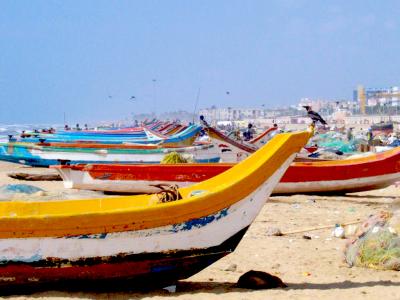OLP 6: The ocean and humans are inextricably interconnected
Fig. 1. OLP 6. Fishing boats in Chennai, India.
Image courtesy National Oceanic and Atmospheric Administration (NOAA) National Ocean Service
Humans have a complex relationship with the ocean. The ocean affects every human life. It supplies freshwater and oxygen, moderates the climate, influences our weather, and affects human health. Humans rely on the ocean for food and transportation (Fig. 1). However, we often act in ways that are harmful to the ocean, including overfishing and polluting the ocean and land.
OLP 6.B
The ocean provides food, medicines, and mineral and energy resources. It supports jobs and national economies, serves as a highway for transportation of goods and people, and plays a role in national security.
OLP 6.C
The ocean is a source of inspiration, recreation, rejuvenation, and discovery. It is also an important element in the heritage of many cultures.
OLP 6.D
Humans affect the ocean in a variety of ways. Laws, regulations, and resource management affect what is taken out and put into the ocean. Human development and activity leads to pollution (point source, non- point source, and noise pollution), changes to ocean chemistry (ocean acidification), and physical modifications (changes to beaches, shores, and rivers). In addition, humans have removed most of the large vertebrates from the ocean.
OLP 6.F
Much of the world’s population lives in coastal areas. Coastal regions are susceptible to natural hazards (tsunamis, hurricanes, cyclones, sea level change, and storm surges).
OLP 6.G
Everyone is responsible for caring for the ocean. The ocean sustains life on Earth and humans must live in ways that sustain the ocean. Individual and collective actions are needed to effectively manage ocean resources for all.










